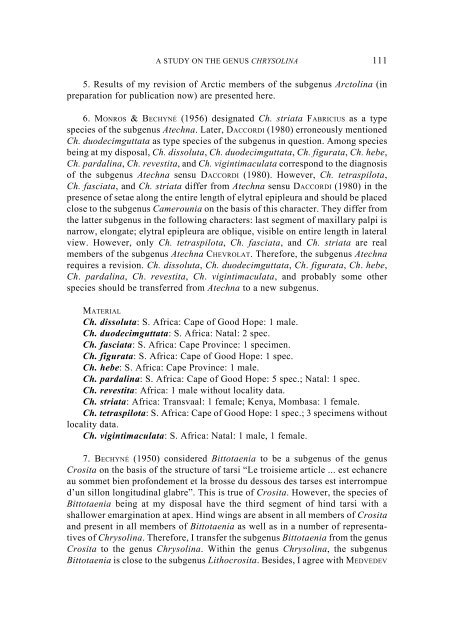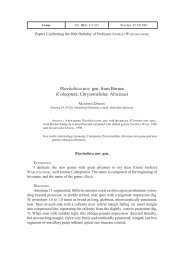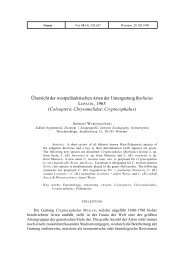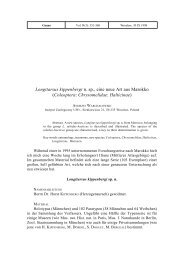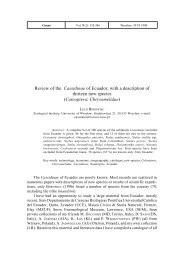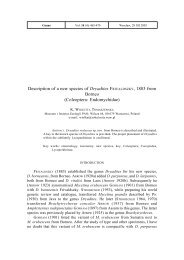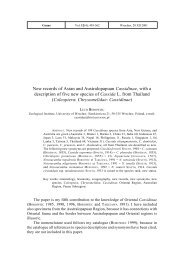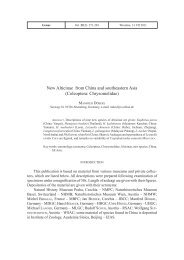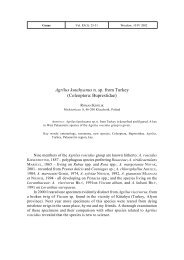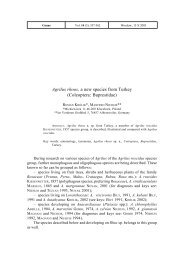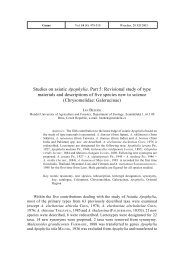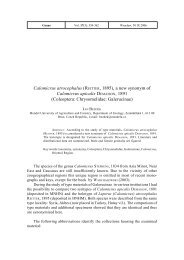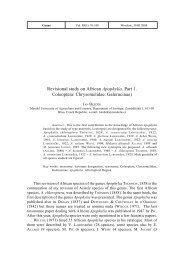A study on the genus Chrysolina MOTSCHULSKY, 1860, with a ...
A study on the genus Chrysolina MOTSCHULSKY, 1860, with a ...
A study on the genus Chrysolina MOTSCHULSKY, 1860, with a ...
You also want an ePaper? Increase the reach of your titles
YUMPU automatically turns print PDFs into web optimized ePapers that Google loves.
A STUDY ON THE GENUS CHRYSOLINA<br />
111<br />
5. Results of my revisi<strong>on</strong> of Arctic members of <strong>the</strong> sub<strong>genus</strong> Arctolina (in<br />
preparati<strong>on</strong> for publicati<strong>on</strong> now) are presented here.<br />
6. MONROS & BECHYNÉ (1956) designated Ch. striata FABRICIUS as a type<br />
species of <strong>the</strong> sub<strong>genus</strong> Atechna. Later, DACCORDI (1980) err<strong>on</strong>eously menti<strong>on</strong>ed<br />
Ch. duodecimguttata as type species of <strong>the</strong> sub<strong>genus</strong> in questi<strong>on</strong>. Am<strong>on</strong>g species<br />
being at my disposal, Ch. dissoluta, Ch. duodecimguttata, Ch. figurata, Ch. hebe,<br />
Ch. pardalina, Ch. revestita, and Ch. vigintimaculata corresp<strong>on</strong>d to <strong>the</strong> diagnosis<br />
of <strong>the</strong> sub<strong>genus</strong> Atechna sensu DACCORDI (1980). However, Ch. tetraspilota,<br />
Ch. fasciata, and Ch. striata differ from Atechna sensu DACCORDI (1980) in <strong>the</strong><br />
presence of setae al<strong>on</strong>g <strong>the</strong> entire length of elytral epipleura and should be placed<br />
close to <strong>the</strong> sub<strong>genus</strong> Camerounia <strong>on</strong> <strong>the</strong> basis of this character. They differ from<br />
<strong>the</strong> latter sub<strong>genus</strong> in <strong>the</strong> following characters: last segment of maxillary palpi is<br />
narrow, el<strong>on</strong>gate; elytral epipleura are oblique, visible <strong>on</strong> entire length in lateral<br />
view. However, <strong>on</strong>ly Ch. tetraspilota, Ch. fasciata, and Ch. striata are real<br />
members of <strong>the</strong> sub<strong>genus</strong> Atechna CHEVROLAT. Therefore, <strong>the</strong> sub<strong>genus</strong> Atechna<br />
requires a revisi<strong>on</strong>. Ch. dissoluta, Ch. duodecimguttata, Ch. figurata, Ch. hebe,<br />
Ch. pardalina, Ch. revestita, Ch. vigintimaculata, and probably some o<strong>the</strong>r<br />
species should be transferred from Atechna to a new sub<strong>genus</strong>.<br />
MATERIAL<br />
Ch. dissoluta: S. Africa: Cape of Good Hope: 1 male.<br />
Ch. duodecimguttata: S. Africa: Natal: 2 spec.<br />
Ch. fasciata: S. Africa: Cape Province: 1 specimen.<br />
Ch. figurata: S. Africa: Cape of Good Hope: 1 spec.<br />
Ch. hebe: S. Africa: Cape Province: 1 male.<br />
Ch. pardalina: S. Africa: Cape of Good Hope: 5 spec.; Natal: 1 spec.<br />
Ch. revestita: Africa: 1 male <strong>with</strong>out locality data.<br />
Ch. striata: Africa: Transvaal: 1 female; Kenya, Mombasa: 1 female.<br />
Ch. tetraspilota: S. Africa: Cape of Good Hope: 1 spec.; 3 specimens <strong>with</strong>out<br />
locality data.<br />
Ch. vigintimaculata: S. Africa: Natal: 1 male, 1 female.<br />
7. BECHYNÉ (1950) c<strong>on</strong>sidered Bittotaenia to be a sub<strong>genus</strong> of <strong>the</strong> <strong>genus</strong><br />
Crosita <strong>on</strong> <strong>the</strong> basis of <strong>the</strong> structure of tarsi “Le troisieme article ... est echancre<br />
au sommet bien prof<strong>on</strong>dement et la brosse du dessous des tarses est interrompue<br />
d’un sill<strong>on</strong> l<strong>on</strong>gitudinal glabre”. This is true of Crosita. However, <strong>the</strong> species of<br />
Bittotaenia being at my disposal have <strong>the</strong> third segment of hind tarsi <strong>with</strong> a<br />
shallower emarginati<strong>on</strong> at apex. Hind wings are absent in all members of Crosita<br />
and present in all members of Bittotaenia as well as in a number of representatives<br />
of <strong>Chrysolina</strong>. Therefore, I transfer <strong>the</strong> sub<strong>genus</strong> Bittotaenia from <strong>the</strong> <strong>genus</strong><br />
Crosita to <strong>the</strong> <strong>genus</strong> <strong>Chrysolina</strong>. Within <strong>the</strong> <strong>genus</strong> <strong>Chrysolina</strong>, <strong>the</strong> sub<strong>genus</strong><br />
Bittotaenia is close to <strong>the</strong> sub<strong>genus</strong> Lithocrosita. Besides, I agree <strong>with</strong> MEDVEDEV


